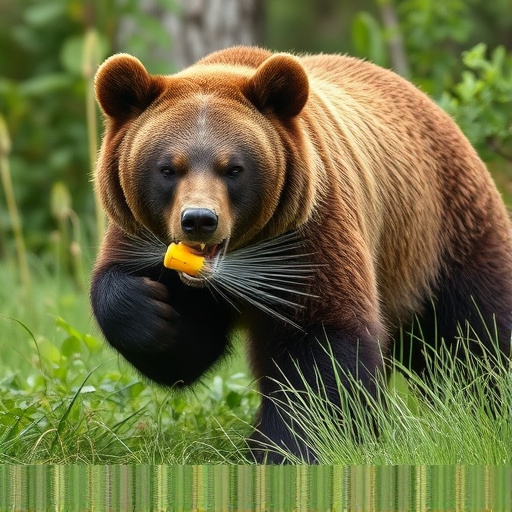Understanding bear behavior and the factors affecting oleoresin capsicum (OC) bear spray effectiveness is crucial for outdoor adventurers in bear country. OC spray, derived from chili peppers, deters bears through capsaicin units (CU), with higher values indicating stronger performance. Weather, distance, and bear behavior impact spray range and potency. Proper usage techniques, including aiming at the face and eyes, securing a line of sight, and backing away slowly, enhance safety during emergent encounters. Regularly checking expiration dates ensures optimal OC strength.
“Bearing the brunt of a charging bear can be a terrifying scenario, but understanding the efficacy of bear spray—a common defense mechanism—is crucial. This article explores the science behind oleoresin capsicum (OC) bear spray and its effectiveness against aggressive bears. We delve into the factors influencing spray strength and offer best practices for its use in emergent situations, emphasizing the importance of knowing when and how to deploy this powerful tool. By understanding the mechanics of OC bear spray, you’ll gain insights that could prove invaluable in real-world scenarios.”
- Understanding Bear Behavior and Why Spray Isn't Always Effective
- The Science Behind Oleoresin Capsicum (OC) Bear Spray
- Factors Affecting the Strength and Efficacy of Bear Spray
- Best Practices for Using Bear Spray in Emergent Situations
Understanding Bear Behavior and Why Spray Isn't Always Effective
Understanding bear behavior is crucial when considering the effectiveness of bear spray as a defense mechanism. Bears, particularly grizzly bears and black bears, are wild animals with powerful instincts. They primarily avoid humans, but when they feel threatened or surprise attacks occur, they may charge. Bear spray, designed to deter bears using capsaicin, the active ingredient found in chili peppers, is often recommended for bear safety.
However, it’s important to note that not all bear encounters will respond positively to oleoresin capsicum (OC) bear spray. Factors like the strength of the spray—typically measured in OC concentration—and weather conditions can affect its performance. Heavy rain or wind might reduce the spray’s effectiveness, as capsaicin is more potent when it comes into direct contact with a bear’s eyes and muzzle. Additionally, some studies suggest that bears may become desensitized to OC spray after repeated exposure, making it less reliable in certain situations.
The Science Behind Oleoresin Capsicum (OC) Bear Spray
Oleoresin capsicum (OC), the active ingredient in bear spray, is a natural compound derived from chili peppers. Its effectiveness against charging bears lies in its powerful irritant properties. When sprayed into a bear’s eyes and face, OC triggers nerve endings, causing intense pain and temporary blindness. This disruption gives the user valuable time to escape or play dead until the bear loses interest.
The strength of OC bear spray is measured in capsaicin units (CU), with higher CU indicating greater potency. Quality products typically range from 2 million to 3 million CU per can, ensuring a potent enough solution to deter aggressive bears. The science behind OC’s success as a bear deterrent is well-researched and proven, making it a vital tool for outdoor enthusiasts in bear country.
Factors Affecting the Strength and Efficacy of Bear Spray
The effectiveness of bear spray against charging bears depends on several factors, with the primary one being the concentration of oleoresin capsicum (OC), the active ingredient in bear spray. Higher concentrations of OC in bear spray translate to increased strength and efficacy. Bear spray strength is typically measured in capsaicin units (CU), with higher CU indicating a stronger spray.
Other factors that influence bear spray performance include weather conditions, distance to the bear, and the bear’s behavior. For example, rainy or windy weather can reduce the spray’s range and effectiveness. Additionally, if a bear is already agitated or charging directly at you, it may require more than one application of bear spray to deter it. Therefore, proper usage techniques and understanding these variables are crucial for maximizing the protection provided by bear spray.
Best Practices for Using Bear Spray in Emergent Situations
In emergent situations where a bear charges, proper usage of oleoresin capsicum (OC) bear spray is key to self-defense. It’s crucial to remember that OC spray is most effective when used at close range, generally within 20–30 feet (6–9 meters). Aim for the bear’s face and eyes, as these areas contain numerous nerve endings, causing the bear to stop and retreat.
Best practices include ensuring you have a clear line of sight to the charging bear before activating the spray. Activate the spray in quick successive bursts, typically 3–4 bursts lasting about 2 seconds each, from a distance that allows for maximum effect. After spraying, back away slowly while maintaining eye contact with the bear to monitor its behavior and ensure it retreats. Regularly check the expiration date of your bear spray, as OC strength degrades over time.
Bear encounters can be frightening, but understanding the science behind bear spray, specifically its active ingredient oleoresin capsicum (OC), is key to effective protection. While OC bear spray has proven successful in deterring charging bears due to its intense capsaicin content, various factors like weather conditions and bear species can impact its strength and efficacy. Following best practices for usage, such as proper application techniques and staying calm during encounters, ensures maximum effectiveness when facing aggressive bears. Remember, bear spray is a valuable tool, but awareness of its limitations and responsible use are essential in navigating wild environments.
